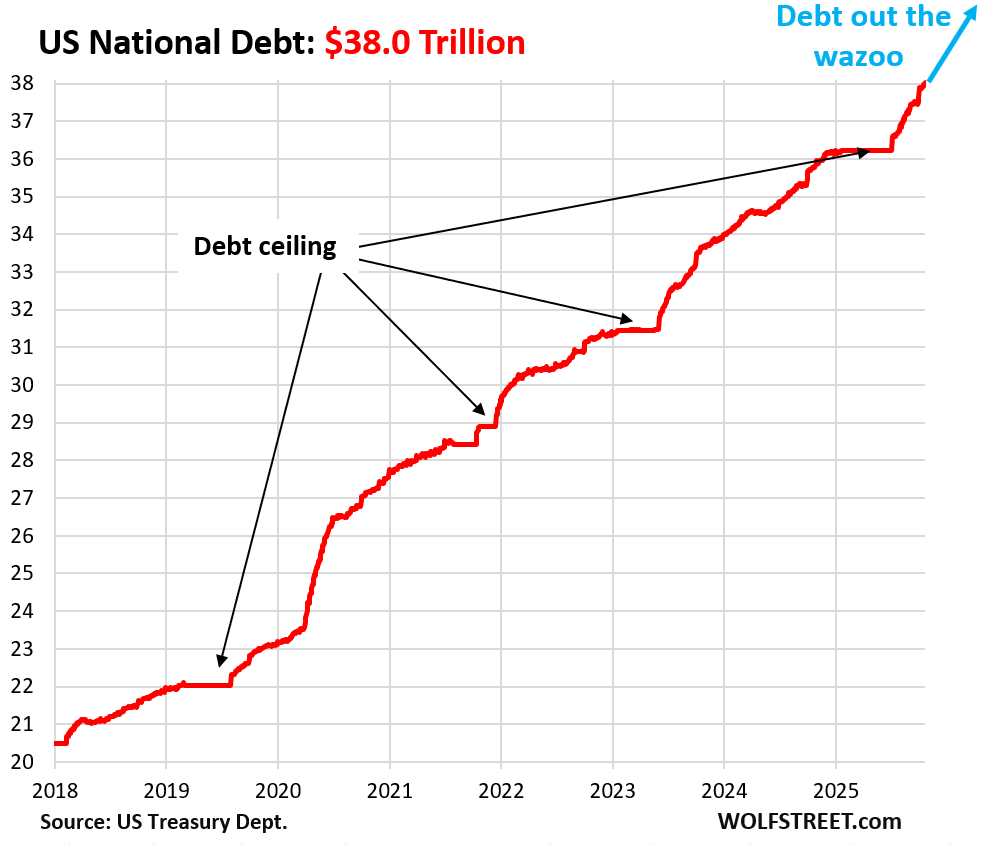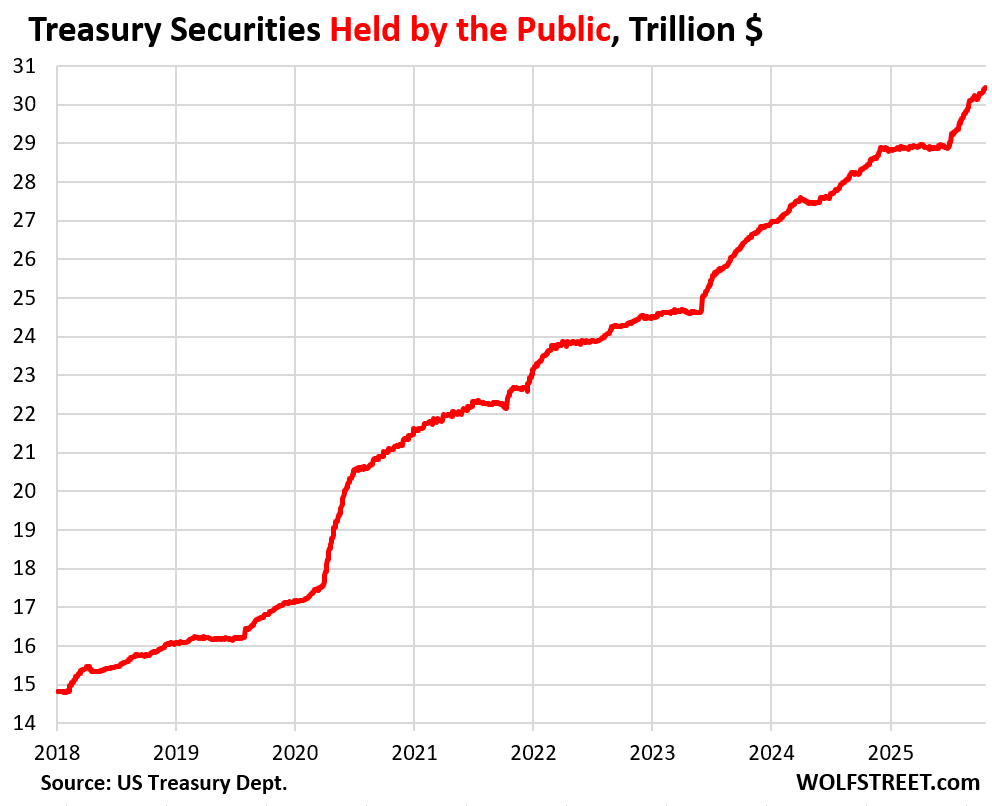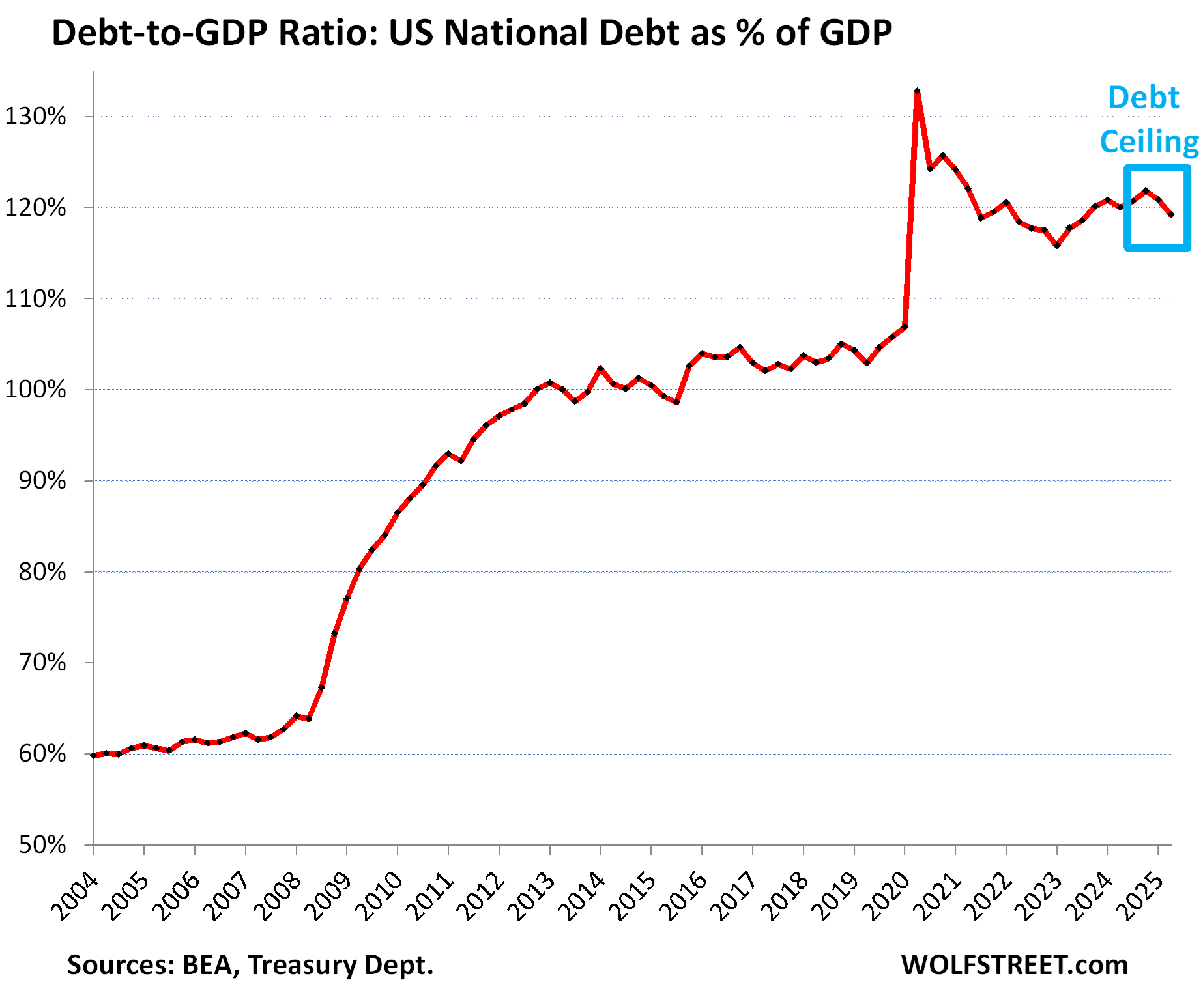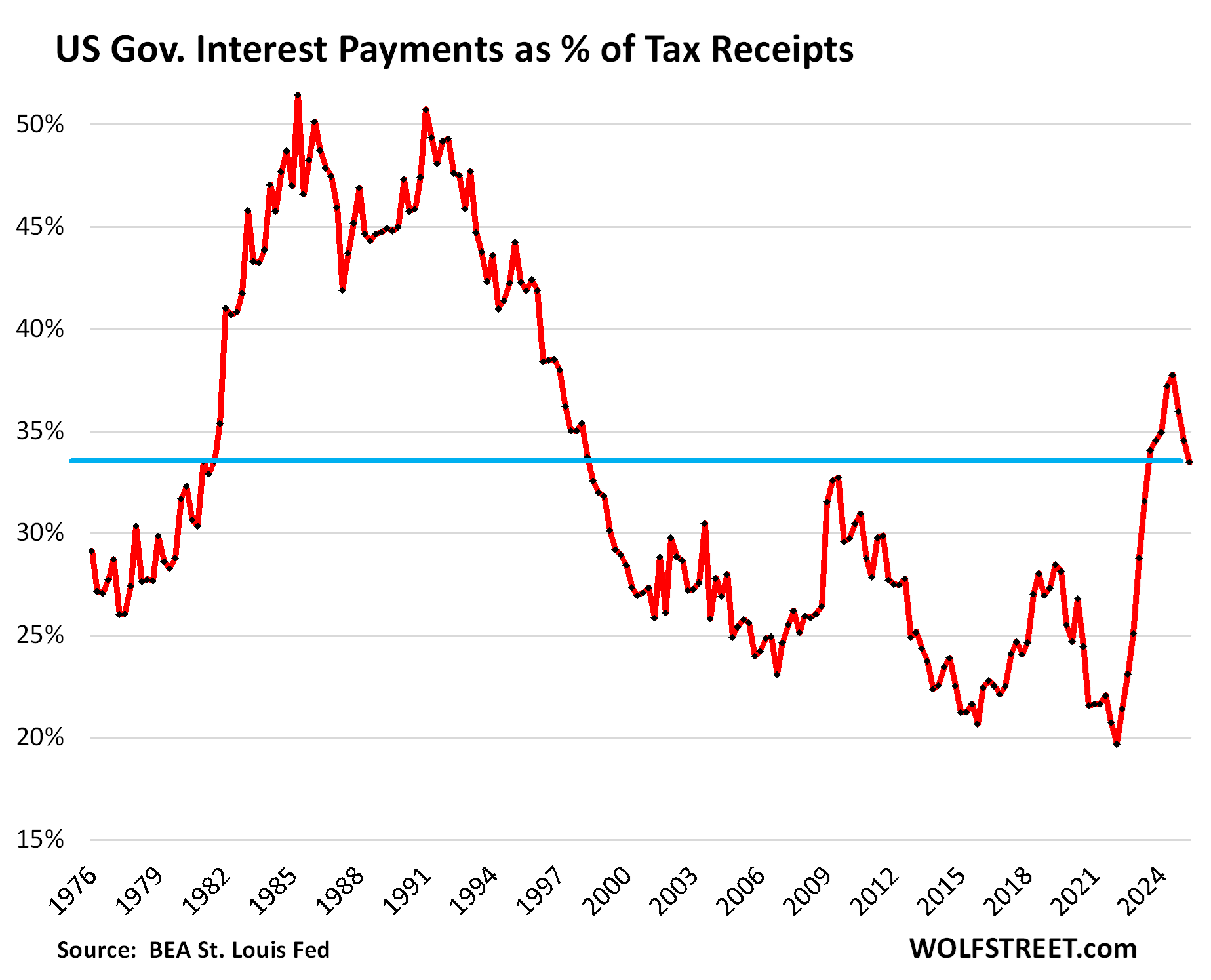But debt and interest expense don’t exist in a vacuum.
By Wolf Richter for WOLF STREET.
The US Treasury debt – all Treasury securities outstanding – jumped by another $40 billion today and thereby went over the $38-trillion mark, to $38.012 trillion to be precise, only two-and-a-half months after it had hit the $37-trillion mark on August 8, according to data from the Treasury Department today.
Since the debt ceiling in early July, so in three-and-a-half months, the debt has soared by $1.8 trillion. Trillions are flying by the window so fast they’re hard to see.
The flat spots occur during the debt ceiling, or as a WOLF STREET commenter put it so unforgettably, during the “debt floor.”

Of that $38.01 trillion in Treasury securities, $30.44 trillion are “held by the public” – they’re the publicly traded Treasury securities held in accounts in the US and around the world, in brokerage accounts, by banks, by insurance companies, at financial centers, by central banks, by the Fed, etc.

The remaining $7.58 trillion of the debt are held in federal government pension funds, the Social Security Trust Fund, and other “internal” government accounts, and they’re not traded.
Yields rise until there is sufficient demand. So there will always be demand for Treasury securities, but maybe not at sustainable yields.
But yields on longer-term securities are currently relatively low – with the 10-year Treasury yield only about 1 percentage point above the CPI inflation rate for August – indicating that there is ravenous demand for Treasuries. If there is less demand, yields will rise until there is enough demand. This happens in real time at the Treasury auctions and in the market. Higher yields create demand, but they also increases the interest expense and that becomes a problem at some point.
But debt and interest expense don’t exist in a vacuum.
The surrounding factors are the growth of the overall economy, as measured by nominal GDP, and tax receipts, which are linked. They’re essentially what pays for the interest expense (discussion and further details here).
The Debt-to-GDP ratio eased in Q2 for the second consecutive quarter to 119.3% because the debt ceiling temporarily blocked the debt from growing over the first six months this year and kept it at $36.2 trillion through Q2.
The debt-to-GDP ratio for Q3 will likely look worse, though GDP growth seems to be pretty good so far, but the debt jumped by $1.65 trillion in Q3.

Federal tax receipts jumped, powered by capital gains taxes and further boosted by the new tariffs in Q2. This measure of tax receipts, released by the Bureau of Economic Analysis, tracks the tax receipts that are available to pay for general budget expenditures, such as interest payments. Excluded are receipts that are not available to pay for general budget expenditures and are not part of the general budget, primarily Social Security and disability contributions that go into Trust Funds, out of which the benefits are then paid directly to the beneficiaries.
Interest payments by the federal government also rose but less than tax receipts.
What portion of federal tax receipts gets eaten up by interest payments? It’s bad, but not as bad as it was during the last crisis in the early 1980s.
Interest payments ate up 33.5% of the tax receipts that were available to pay for them in Q2. The ratio declined for the third consecutive quarter, driven by higher tax receipts, including from capital gains taxes and tariffs.

Enjoy reading WOLF STREET and want to support it? You can donate. I appreciate it immensely. Click on the mug to find out how:
![]()


“with the 10-year Treasury yield only about 1 percentage point above the CPI inflation rate for August – indicating that there is ravenous demand for Treasuries. If there is less demand, yields will rise until there is enough demand.”
This conclusion would be normal in a fair market but Treasury market is not fair, Government interferes the market through primary dealers all the time , they sell short term debt and use this money to buy the long term treasuries when there is less demand and decreasing the yields, skew the rates, basically they are decreasing the maturity of US debt, this is similar to kicking the can down the road, problem (of less long term demand) will come back bigger in 2-3 years.
Agree. But no one should be surprised. Both the US government and the FED have been doing this for years. That is a FED mandate.
john,
“they sell short term debt and use this money to buy the long term treasuries when there is less demand and decreasing the yields”
that’s just headline goofball nonsense.
The buybacks are minuscule and have no impact on long-term yields. All you have to do is look it up. For example, at the weekly buyback auctions:
This week (at the weekly buyback auction yesterday), the government bought back $1.9 billion, all maturing in 2-3 years. Most of them, it bought back at a discount of 94 to 95 cents on the dollar, one issue it bought back at a premium (4% coupon!) of 101 cents on the dollar.
Last week, it bought back just $192 million with an M.
The Treasury Debt here is measured in Trillions with a T, $38 trillion, with a growth of $1 trillion in 2.5 months. Issuance every WEEK is running in the $400-$700 billion range. So how do buybacks of $192 million to $2 billion a week matter?
Another great win!
Fascinating that the interest as a percentage of tax receipts is still relatively low compared to the ’80’s and ’90’s. The net is so full of doomers proclaiming the end times any minute now. I guess the numbers sound too big for us olds.
Much different economy and geopolitical situation today.
If the US ever loses control of its bond market, there will be a sovereign debt crisis. That is what we’re up against.
In those times, overall Federal debt as it relates to GDP was half what it is now, and the press and general population was very concerned about the deficit. Now the press doesn’t even talk about it and there is no public outcry. The inevitable outcome will be inflation, there is no way out.
I still don’t understand why government expenditures are counted as contributing to the GDP, because all gov-exp’s are a burden on the economy in the form of taxes or in the form of debts to be paid/worked for later.
Only a portion of government expenditures are counted in GDP, namely investments (for example infrastructure construction) and consumption (such as buying goods and services that the government “consumes.”) Government salaries don’t go into GDP, Social Security benefit payments don’t go into GDP, etc. They’re counted when they’re spent by the recipients. GDP is very complex.
How long can one expect the US to spend more than it earns before it defaults on its debt or pays it back with worthless dollars through simply firing up the money printing press? Nobody appears to be asking this question
The answer is that politicians, here the Congress, will vote to do it forever. You also hit the nail on the head that there are two alternative results of this. Actual default or alternatively inflate away the debt to manageable level. Yes, that will be done with modern electronic printing press.
The end date may be the day the private sector bond market buyers ( including foreigners and foreign central banks) refuse to purchase the debt, even though nominal rates are very high, because real rates are too low or negative.
If the ONLY buyer for US Treasuries becomes the FED, then the end will be near.
You are asking the correct question. I know you are not looking for a “ date” certain. Assume you are looking for the factors or a clear set of signs.
Not sure anyone knows for sure.
This has already happened. Ever notice how the price of gas has tripled in 25 years? Or a new car has more than doubled? Can of soda from the machine went from 35 cents to a dollar?
The Fed conjures up new dollars all the time to feed the debt machine. Those dollars aren’t “worthless” but they sure are worth less.
Just extrapolate up and you’ve got it. In 2050 the national debt could be $90 trillion and that can of coke might cost $3.
Sure, there has been a lot of inflation, but…
1. “the price of gas has tripled in 25 years”
the price of gasoline is now LOWER than it was in 2008. The big increase came in 2000-2008, as the price oil soared. Since 2008, gasoline has been wobbling up and down in the same range, with essentially no inflation. Since mid-2022, the price of gasoline has PLUNGED by 35%, as the dollar became worth MORE.
2. The price of a laptop went from $2,000 in 1995 for something that was essentially useless to $600 today that is essentially a super-computer by 1995 standards, as the dollar became worth a lot MORE.
3. “Or a new car has more than doubled?”
Yes, but you get a car that is multiple times better in every aspect than the POS death-trap you got in the 1990s.
Goofball jerry-picking produces goofball results.
Basically, until someone supplants us as the top military power in the world, which isn’t likely for the foreseeable future.
A long time because the world sees the U S as a place where they are not so concerned about the return they get on their money but the confidence of the return of their money.
@Rico Years ago I heard someone say we should not get worried until rich Americans start sending their kids to Chinese Universities and investing in Chinese Real Estate.
So where/how does one hide from this? Buy real estate? Buy gold and silver? Something else? Or just don’t worry and keep the money in the stock market because it will go higher and higher?
Just a reminder
ONE BILLION seconds is about 32 years
ONE TRILLION seconds is about 320 CENTURIES!
The game of small integers that is played in Washington DC…….when bills tack on .1 or .2 Trillion to a bill appears trivial at first blush.
Curious now that servicing the debt is some kind of surprise in Washington DC.
yes, but “320 CENTURIES” in terms of the age of the universe is just a blip.
…I can only think back to ol’ Ev Dirksen and imagine the look on his face if informed that ‘a million here. a million there’ jest would blow through ‘a billion’ to ‘a trillion’ as being ‘real money’ less than a hundred years hence. Being born into, and growing up in, times of constant general quant uncertainty and perception indicate yet another serious disruption of meaningful and effective long-term communication and cooperation between our current contemporary generations…
may we all find a better day.
I have always found this factoid interesting when speaking about the issue of debt.
This tells me that the problem is not able to be solved.
“The total net worth of all billionaires in the United States has been estimated at around $6 trillion as of 2025.
If this wealth were fully confiscated, it would fund approximately 9 months of federal government spending, based on a 2025 budget of about $6.75 trillion”.
This is why the “Tax the Rich” thing is sophistry, the problem is now and has always been spending, under both parties as has been clearly shown. Someone is going to need to take a sledgehammer to Federal spending. Musk used tweezers.
You also have to get people back to productivity and end the bailouts of every industry.
Generational welfare should not be a thing nor should corporate welfare.
Proposal: eliminate all funding to individual States. No more pork. Zero dollars given. Zilch. No matter what. Federal programs stay open and run for now. Military still stays funded. Doesn’t matter how loudly the States cry for that money. Cut them off.
The other issue is that you can’t confiscate the wealth, as most of it is based on bubble valuations.
And when you went to confiscate it, you would find the value much less than expected, as the stock market tanks (and the market for superyachts, fine art, etc.)
“A sustainable fiscal policy is defined in this Financial Report as one where the debt-to-GDP ratio is stable or declining over the long term. The projections based on the assumptions in this Financial Report indicate that current policy is not sustainable”
https://fiscal.treasury.gov/reports-statements/financial-report/mda-unsustainable-fiscal-path.html
To grow out of the deficits it is necessary to eliminate the leakages in the circular flow of income, e.g., funds dissipated in financial investment, funds involving the transfer of title to goods, properties, or claims thereto…leakages which do not add “value to product”, in national income. This draws off a net volume of funds that would otherwise have been spent on current output.
What needs to be done regarding federal spending is across the board cuts of 25% to 50% affecting every single program.
Agreed.
The big 3 need serious reforms. Defense, SS, and Medicare/Medicaid.
No politician has the balls to do it because they care more about staying in power than fixing problems.
Surely there has to be an off-ramp for those programs that can be set in stone and phased out slowly to avoid significant disruptions.
For the millionth time:
Social Security is NOT part of the budget. And it’s NOT part of the debt. And it does NOT contribute to the deficit. Social Security is self-funded and had a SURPLUS for over 25 years that it accumulated in the Trust Fund which invested it in Treasury securities ($2.7 trillion), and it only recently has been running a deficit that is paid for entirely out of the Trust Fund and neither impacts the debt nor the deficit.
When people throw SS into budget or debt discussions, they’re either don’t know better or are manipulative watercarriers for the ultra-rich that loathe SS and want to wreck it.
SS does need to be tweaked a little to bring it back into neutral or surplus territory. A combination of tweaks is all it takes — like it was done in the 1980s (by pushing out the retirement age and tweaking contributions), which then produced the huge surplus. Boomers largely paid for those tweaks and the surplus so that they would have something to retire on, and it worked. Now SS needs another set of tweaks. But that has nothing to do with the debt or the budget.
@Wolf, what do you mean when you say “the ultra-rich that loathe SS and want to wreck it”. Most of the people I know are “pretty” rich (not “utra” rich like Elon Musk) and we all like it that people that did not save and invest for old age get a check every month (I’ve been personally getting a check every month since I turned 62 since I expect that “pretty” rich people like me will get cut off before I die.
We should create a scale of richness. Something like:
ultra rich
super rich
very rich
pretty rich
rich
kind of rich
almost kind of rich
barely not rich
not at all rich
far from rich
etc.
There are 4ways of addressing the debt
1 Inflate it away.
2 Pay it down by raising taxes.
3 Default on it.
4 Increase productivity (innovate) and grow the economy, and therefore the tax base.
The first 3 ways are really non starters, we must hope that we can pull off # 4
I had to say this, Rodger, but number 1 is a very likely option, at least historically speaking.
Wolf, up in Canada the PM has been speaking about balancing the “operating budget” while running a significant deficit for large capital investments to spur growth. I’m curious if you think there is any merit to this approach and if this may apply in the situation of the US.
Corporate financial accounting works that way, where capital investments are not expensed when made, but are expensed over time through depreciation. This is called “accrual accounting.”
The US government doesn’t use accrual accounting; it uses “cash accounting” where investment and consumption are expensed when paid for.
My understanding is that Canada’s federal government uses two measures, one cash accounting for the primary deficit; and two accrual accounting for net operating cost. So if my understanding is correct, Carney was referring to the accrual method of the net operating cost.